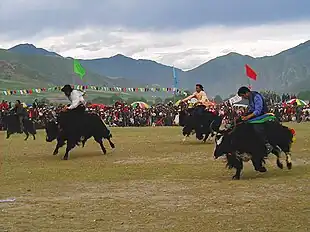Traditional games of Tibet
Traditional games
Board games
Sho
Sho ( Tibetan : ཤོ ) is a traditional race game in Tibet, still common today.[7]
Its name is simply the Tibetan word for "dice".[7] It is traditionally played for money and by men, with two to four players - three being the most common. With four players, the usual variant is to play as two teams of two, with the partners sitting opposite each other.Ming Mang
| a | b | c | d | e | f | g | h | ||
| 8 |  | 8 | |||||||
| 7 | 7 | ||||||||
| 6 | 6 | ||||||||
| 5 | 5 | ||||||||
| 4 | 4 | ||||||||
| 3 | 3 | ||||||||
| 2 | 2 | ||||||||
| 1 | 1 | ||||||||
| a | b | c | d | e | f | g | h | ||
Starting positions for Ming Mang
Animal events
Horse racing
The Litang Horse Festival is a summer horse festival held in Litang County, Sichuan province, China. Khampas from all over the Tibetan Plateau come to trade, celebrate and ride. Khampas are Tibetan nomads who are usually herders.
Polo

Players playing polo
Polo has been played in Tibet since at least the early eight century.[1]
Yak racing

A yak race
References
- Thomas, David (2019-07-24). "Many ancient sports and games are very popular in Tibet". Tibet post International. Retrieved 2023-08-24.
- "Development of Tibetan Traditional Sports". en.chinaculture.org. Retrieved 2023-08-24.
- Dimeo, Paul; Mills, James (2013-10-23). Soccer in South Asia: Empire, Nation, Diaspora. Routledge. ISBN 978-1-135-27657-7.
- "The Tibetan sport of rock-carrying _News_TIBET". m.tibet.cn. Retrieved 2023-08-24.
- "Let´s play Tibetan Snooker -- Gyiren CCTV-International". www.cctv.com. Retrieved 2023-08-24.
- "Tibetan snooker_Sports & Adventure_TIBET". m.tibet.cn. Retrieved 2023-08-24.
- Murakami, Daisuke (April 2014). "Aspects of the Traditional Gambling Game known as Sho in Modern Lhasa — religious and gendered worldviews infusing the Tibetan dice game —". Revue d'Études Tibétaines (29): 245–270. S2CID 54691303.
- Shotwell, Peter. A Form of Tibetan Mig-Mang From the West?. Archived from the original on 6 September 2015. Retrieved 12 July 2016.
{{cite book}}: CS1 maint: bot: original URL status unknown (link) - West, Andrew (4 March 2006). "Tibetan Go". BabelStone Blog. Archived from the original on 11 September 2016. Retrieved 12 July 2016.
- Walker, Damian. "Ming Mang (Leaflet #55)". Cyningstan Traditional Board Games. Retrieved 12 July 2016.
- Bue, Erberto F. Lo (2011). Proceedings of the Tenth Seminar of the IATS, 2003. Volume 13: Art in Tibet Issues in Traditional Tibetan Art From the Seventh to Twentieth Century. Leiden, The Netherlands: Koninklijke Brill NV. p. 146. ISBN 9789004155190.
- Winther, Mats. "Tibetan Gundru". Board games. Retrieved 12 July 2016.
- Botermans, Jack (2008). The Book of Games: Strategy, Tactics & History (1st. ed.). New York, NY / London: Sterling Publishing Co., Inc. pp. 619–626. ISBN 978-1-4027-4221-7. Retrieved 12 July 2016.
- "THE HISTORY OF POLO". argentinapolo.com.
- "Yak Races". Life on the Tibetan Plateau. Archived from the original on 2007-09-27. Retrieved 2007-07-15.
- China Folklore Photographic Association. "Yak Racing". Archived from the original on 2007-09-28. Retrieved 2007-07-15.
- Mark Pennington (1 September 2008). Teaching Reading Strategies. Mark Pennington. pp. 298–. ISBN 978-0-578-01766-2. Retrieved 1 April 2013.
This article is issued from Wikipedia. The text is licensed under Creative Commons - Attribution - Sharealike. Additional terms may apply for the media files.